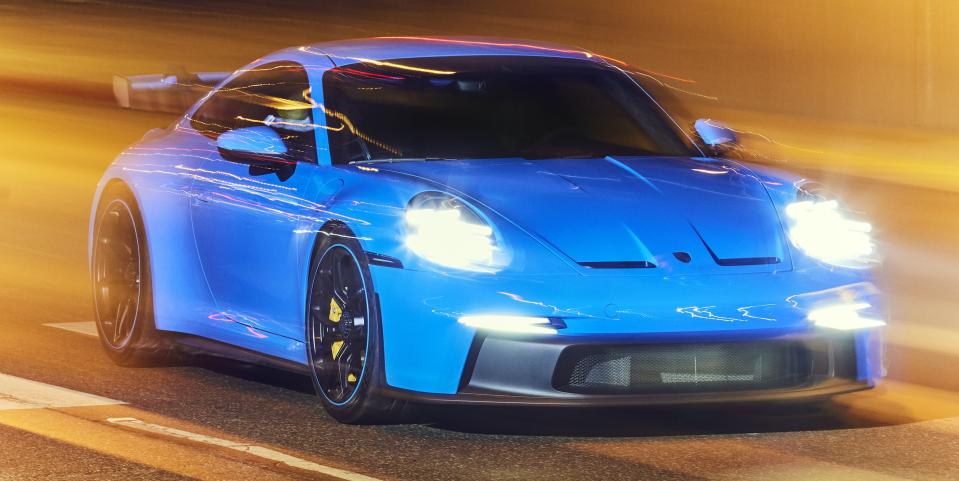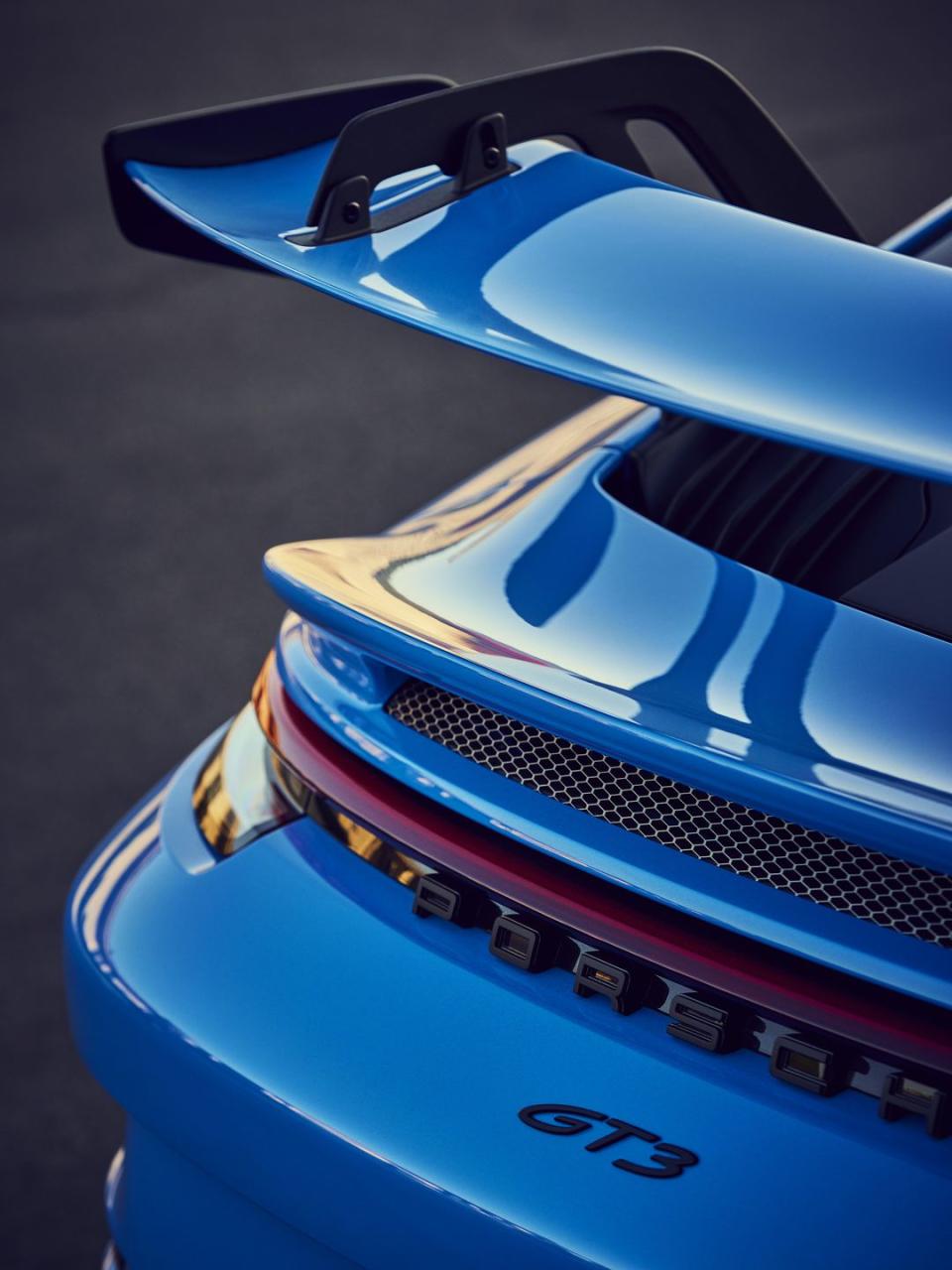The 2022 Porsche 911 GT3 Approaches Motoring Perfection


Ten years ago, the top-spec Porsche 911 Turbo S made 530 hp. The ultimate GT3, the RS 4.0, wasn’t far behind, with 493 hp. Compare to today: A brand-new Turbo S cranks out 640 hp, a 21 percent increase from a decade ago. The brand-new 992-generation GT3 you see here? It only gained nine ponies, to 502.
Around 2009, roadgoing sports cars went ballistic. The Nissan GT-R, the McLaren MP4-12C, and even the 997-generation Porsche 911 Turbo set the standard. Turbocharging, direct injection, and torque-vectoring differentials churned out seem- ingly impossible performance figures: zero to 60 in just over two seconds, quarter-miles in the 10s, and top speeds regularly cracking 200 mph. The normal trickle-down of speed and power became a waterfall, technology avalanching into everyday coupes, sedans, and crossovers. Now Germany offers countless options for a 4500-pound, all- wheel-drive, coupe-shaped SUV with more than 500 hp; heavier but quicker luxury EVs offer even more power.
This story originally appeared in Volume 6 of Road & Track.
SIGN UP FOR THE TRACK CLUB BY R&T FOR MORE EXCLUSIVE STORIES
The streets we live on, the highways we commute on, and the mountain passes we indulge in— they haven’t changed. Neither has our median driving talent. In fact, one might easily argue the opposite. We’re fortunate that crash safety is such a major factor in modern car design.
So speed is more accessible than ever, but driver involvement is in steep decline. Paddles, pitched as the future, led to fewer people buying manuals. Then Ferrari and Lamborghini stopped offering three-pedal cars entirely. The current Acura NSX is an incredibly fast car, but with its all-wheel- drive, hybrid powertrain, it’s a far cry from the simplistic, analog beauty of the original. Ford, which built one of the finest hot hatchbacks in history just four years ago, no longer sells conventional cars in America, Mustang excepted. The company claims nobody wants them. And the newest Mustang is a 4500-pound electric crossover.

The GT3 is naturally aspirated. That’s nonnegotiable. It didn’t mean much in 1999 when the first GT3 came out, since virtually every Porsche road car sucked its own wind. Now, the last naturally aspirated cars in Porsche’s lineup belong exclusively to the GT program. And that should tell you something about this car’s mission.
The GT3 fills two extremely different roles. First, it’s a homologation car for Porsche’s sports-car racing program, exhibiting some fantastic racing-derived technology in its suspension and aerodynamics. It’s also manufactured nostalgia, the last way to still get the old feeling, the old response, the fizz. But, like, with CarPlay now. Ten years ago, 125 hp per liter was just about unbelievable. Now, in this automotive landscape, we can’t believe Porsche is still doing it.
The GT3’s promise—as close as customers can get to the race car, but with a license plate and air- bags—is crucial. The most enthusiastic customers buy these cars, gilding them with personal touches like custom-color paint, contrast stitching, car- bon buckets, sometimes even a matching watch. They drive them a lot, evangelizing the brand. They commute in a Panamera or an all-electric Taycan; their spouses drive Cayennes or Macans. The GT3 comes out for nice days, weekends, and track events. Within the modern 911 world, all roads lead to the GT3. Even if you’ll never afford a GT3, the conversation frequently shifts to, “Well, what can I buy that’ll get me as close to a GT3 as possible?”
In Los Angeles, GT3s are so popular at Cars and Coffee events, it’s possible to develop a disdain for the model and the flat-six zealots who own them. That’s the other conversation: “Everyone has a GT3—what else can I buy that’s as nice to drive and as easy to own?”
I’ve had those thoughts myself. Right up until I get another go in a GT3 and remember that some things get popular by being very, very good.
Whenever there’s a new GT3, it’s a big deal. Here’s your top-line summary: The 992-generation GT3 is bigger in every dimension than its predecessor, uses the same engine and transmission as before, and is 17.5 seconds quicker around the Nürburgring. A 6:55.2 lap around the Nordschleife, with this engine, is unfathomably quick. It’s the closest you can get to the cars Porsche takes endurance racing. The GT3 sounds, looks, feels, and moves almost exactly like those 911 RSR competition cars—the ones that get thrown into Daytona’s Bus Stop for 24 hours on end. This is pure, distilled motorsport theater.
As it turns out, certain types of “bigger” can actually be better in a car like this. The new-generation 911’s growth spurt allowed that famous rear engine to inch its way closer to the middle, improving weight distribution. A bigger body means room for bigger wheels, tires, brakes, even a bigger wing—all very important on track. One thing that hasn’t grown? The curb weight: just 3164 pounds, a gain of only 11 pounds from the last-gen car. Considering how much more space the new car takes up, that’s unreal.
The GT3 is full of trick race-car engineering. Some of it you can see, like the swan-neck wing out back and the vertically ducted radiator exits peering through the front trunk lid. Pair all that with the first-ever functional rear diffuser on a roadgoing 911, and the whole mess can make 150 percent more downforce than the outgoing GT3. Then there’s the suspension, which, in the front at least, is essentially straight off the 911 RSR, with full spherical bushings. What’s that mean? You feel the road, occasionally for the worse, but most of the time for the far better.

The fizz. The new GT3 is every bit as adept as the old one at going fast, providing feedback, and letting you feel like a race-car driver. The engine and seven-speed PDK transmission (a six-speed manual is also available) are the sharpest, most precise motoring instruments available at any price, let alone the relative bargain that this car represents: $161,100 base MSRP. I love the shove of a pair of turbochargers as much as anyone, but this 4.0-liter engine—which makes the same power as it did in the limited-run 911 Speedster, a car that’s 66 pounds heavier than this GT3—is addictive, as is revving it to its 9000-rpm redline.
This is an endurance-racing engine—designed for high-stress, long-distance events—and it shows. One could, for sport, buy a GT3 and never shift it past third gear. You certainly don’t need any of the other four to go well over 100 mph. Fortunately, at this displacement, even in urban commuting, the GT3 never feels sluggish. Stiff? Abusive? Maybe a bit darty on bumpy roads? Yeah, all those things, especially with the optional light- weight carbon buckets. But never sluggish.
One look at the list of cars that can go sub-seven minutes at the Nürburgring will tell you what I learned in an afternoon behind the wheel: This is easily the fastest 500-hp production car in history. Turn-in is ridiculously sharp, thanks to specially calibrated front and rear steering, a phrase you don’t often hear. In the midcorner, the unique suspension architecture prevents the front wheels from moving laterally, something you don’t realize is a problem in any other 911 until you drive this one. Am I really expected to go back?
When the road gets bumpy, the body moves around a lot, but the tires always maintain their contact patches. Like a high-downforce track car, you can drive well past the point of comfort. Fortunately, the brakes are simply perfect. The optional carbon ceramics on our tester save 39 pounds of unsprung weight and certainly won’t fade on public roads. The overall experience is sublime, approaching motoring perfection.
As the choice of the enthusiast, and the variant most closely linked to Porsche’s race cars, the GT3 carries the baton for the entire range. It has to be good—it’s the keystone that holds up the entire family. The new GT3 delivers in the best way possible: by being the lightest variant of the new car, by having a perfect engine, and by bringing in some new tasty bits from the race car. It uses technology to serve the driver’s senses, which just happens to result in speed. Everybody wins.
You Might Also Like

 Yahoo Autos
Yahoo Autos 